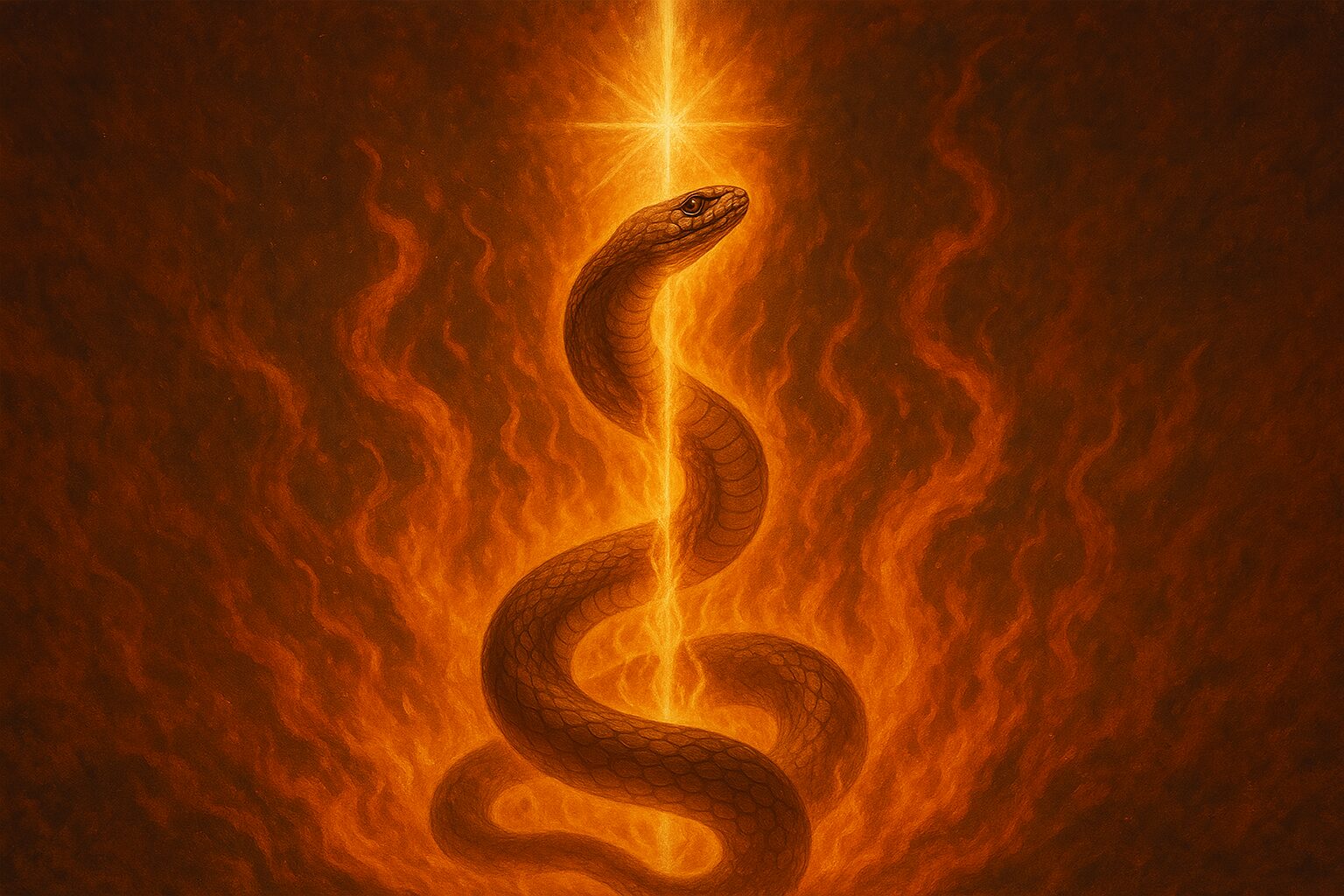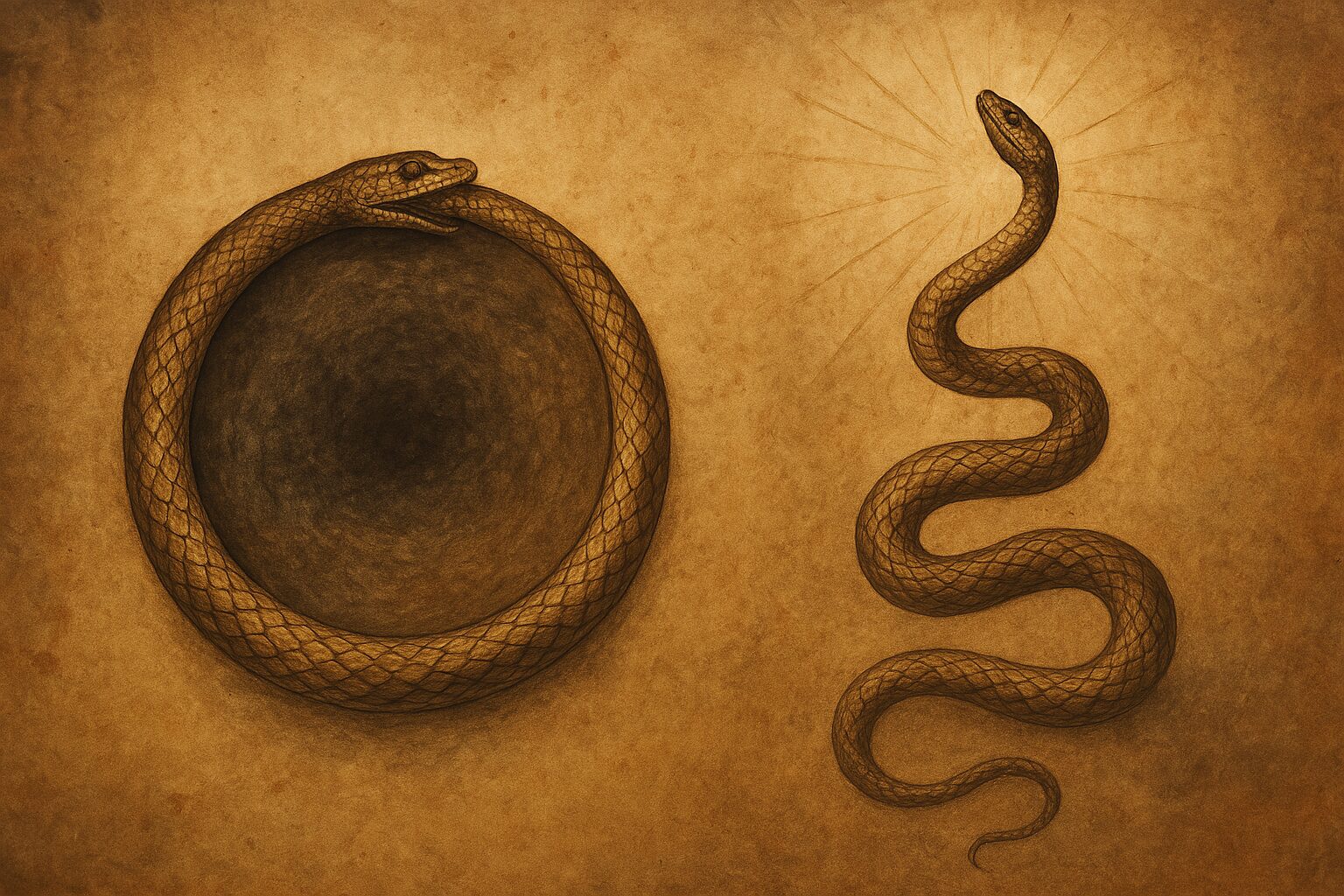Introduction
In mystical traditions around the world, the serpent has been a potent symbol of transformation, wisdom, and power. Within the spiritual practice of Kundalini awakening, this ancient symbol takes on an even deeper significance. Kundalini, often depicted as a coiled serpent at the base of the spine, represents a powerful, dormant spiritual energy that, when awakened, rises up through the chakras to bring enlightenment and self-realization. This article explores the alchemical symbolism of the serpent in relation to Kundalini awakening, unraveling the esoteric meanings behind its fiery ascent and its role in the transformative process of spiritual alchemy.
The Serpent as a Symbol of Transformation
The serpent is a universal symbol of both destruction and creation. In the Bible, the serpent is associated with temptation and fall, but it also carries a deeper, more mystical significance in many cultures. In The Secret Doctrine by Helena Blavatsky, the serpent is described as “the symbol of life,” representing the life force that lies within all beings. In the context of alchemy and Kundalini awakening, the serpent represents the primal energy that, when properly channeled, leads to spiritual rebirth and transformation.
Blavatsky further writes,
“The serpent is the fire, the one who transforms.”
This fire is not a destructive force, but a purifying one. It represents the alchemical process of turning base materials into gold, metaphorically speaking. Similarly, the awakening of Kundalini is not a simple release of energy, but a process of spiritual purification, where the ego is burned away, and the soul ascends to higher levels of consciousness.
Kundalini Awakening: The Fire of the Serpent
In the esoteric traditions of the East, Kundalini is often referred to as “the fiery serpent” because of the intense energy that is unleashed when it rises from its base in the root chakra. This fiery energy ascends through the central channel, or Sushumna, traveling up the spine and activating the chakras. Each chakra represents a level of consciousness, and as the Kundalini serpent ascends, it purifies each chakra, releasing blocked energy and awakening higher faculties of the mind.
The Bible provides a fascinating parallel in the story of Moses and the serpent:
“As Moses lifted up the serpent in the wilderness, even so must the Son of Man be lifted up”
(John 3:14)
This passage can be interpreted in mystical terms, suggesting that the spiritual ascent of the serpent represents the elevation of the soul to higher planes. The lifting up of the serpent is symbolic of the Kundalini rising through the chakras, bringing with it spiritual awakening and enlightenment.
In alchemy, fire is the most potent element, associated with purification and the transmutation of base substances into their highest form. The serpent’s fiery ascent, then, can be understood as a symbolic purification of the individual, a spiritual alchemy that transforms the soul from its base state of ignorance to one of divine wisdom and enlightenment.
The Seven Chakras: The Path of Transformation
Kundalini awakening is often depicted as a journey through seven stages, corresponding to the seven main chakras. These energy centers are believed to govern various aspects of our physical, emotional, and spiritual well-being. As the serpent ascends through the chakras, it activates each one, dissolving blockages and facilitating the integration of higher wisdom.
- Root Chakra (Muladhara): The base of the spine, where the Kundalini serpent lies dormant. This chakra represents our foundation and connection to the earth. The serpent’s awakening begins here, grounding us in our physical existence before rising to higher realms.
- Sacral Chakra (Svadhisthana): Associated with creativity, sexuality, and emotions, this chakra governs our ability to flow with life. As Kundalini rises through this chakra, the serpent’s fire ignites our creative potential and emotional clarity.
- Solar Plexus Chakra (Manipura): The center of personal power and will, this chakra governs our self-esteem and autonomy. The serpent’s passage through the solar plexus activates inner strength and a deeper sense of purpose.
- Heart Chakra (Anahata): The seat of love and compassion, the heart chakra is where the individual connects to higher, universal love. Kundalini’s journey through this chakra opens the heart, allowing unconditional love and compassion to flow.
- Throat Chakra (Vishuddha): The center of communication and expression, this chakra is associated with the ability to speak one’s truth. The serpent’s fiery ascent through the throat chakra enables the practitioner to communicate with clarity and authenticity.
- Third Eye Chakra (Ajna): The seat of intuition and insight, the third eye governs our perception of reality beyond the physical. As the serpent rises through the third eye, it activates inner vision and wisdom, allowing for greater spiritual insight.
- Crown Chakra (Sahasrara): The final destination of the Kundalini serpent, the crown chakra represents the connection to divine consciousness. When Kundalini reaches this chakra, the individual experiences spiritual enlightenment, union with the divine, and a state of cosmic awareness.
The Alchemical Process of Kundalini Awakening
The awakening of Kundalini can be likened to the alchemical process of turning base metals into gold. In alchemy, the philosopher’s stone is the ultimate goal, a substance that can transmute lead into gold and grant immortality. Similarly, in the process of Kundalini awakening, the base energy of the serpent is transmuted into spiritual gold, leading the initiate to self-realization and enlightenment.
“That which is below is like that which is above, and that which is above is like that which is below, to accomplish the miracle of one thing.”
The Emerald Tablet
This alchemical axiom can be applied to the process of Kundalini awakening, suggesting that the transformation of the inner self mirrors the transformation of the outer world. As the serpent rises, it purifies the individual, dissolving ego-based attachments and awakening the divine wisdom that lies dormant within.
As the serpent rises through the chakras, it ignites the fire of spiritual transformation. The fire of Kundalini is not to be feared, for it is a sacred flame that burns away impurities, revealing the true essence of the self. This process is the spiritual alchemy of the soul, turning the lead of ignorance into the gold of enlightenment.
Conclusion
The alchemical symbolism of the serpent and the fire represents the transformative power of Kundalini awakening. Through the ascent of the serpent, an initiate undergoes a process of spiritual purification and self-realization, transmuting base energies into higher states of consciousness. The serpent, as both a symbol of destruction and creation, embodies the dual nature of spiritual transformation. It is through the fiery awakening of Kundalini that one can achieve enlightenment, spiritual wisdom, and a deeper connection to the divine.
In the words of Carl Jung:
“When the fire of the spirit rises from within, it transforms everything it touches.”
The Kundalini serpent is this fire, and its ascent is the path to the ultimate transmutation of the soul.


